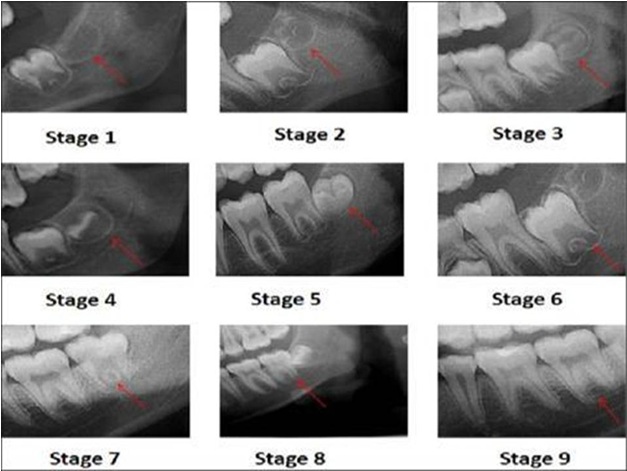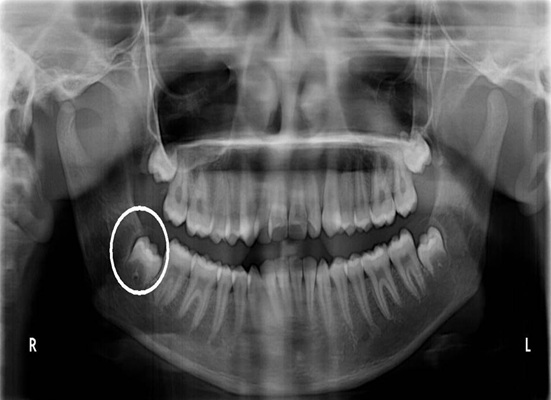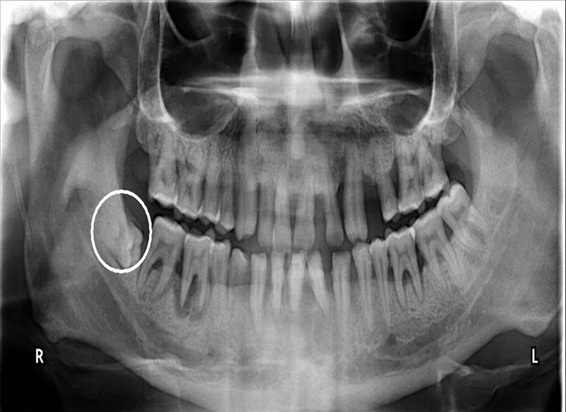Reliability of Third Molar Development for Age Estimation by Radiographic Examination (Demirjian’s Method)
Sushil B Naik1, Swapnil N Patil2, Seema D Kamble3, Tushar Mowade4, Pavan Motghare5
1 Lecturer, Department of Public Health Dentistry, VSPM’s Dental College & Research Centre, Nagpur, Maharashtra, India.
2 Lecturer, Department of Public Health Dentistry, VSPM’s Dental College & Research Centre, Nagpur, Maharashtra, India.
3 Lecturer, Department of Public Health Dentistry, Nair Hospital and Dental CollegeMumbai, Maharashtra, India.
4 Reader, Department of Prosthodontics, VSPM’s Dental College & Research Centre, Nagpur, Maharashtra, India.
5 Reader, Department of Oral Medicine and Radiology, VSPM’s Dental College & Research Centre, Nagpur, Maharashtra, India.
NAME, ADDRESS, E-MAIL ID OF THE CORRESPONDING AUTHOR: Dr. Sushil B Naik, Lecturer, Department of Public Health Dentistry, VSPM’s Dental College and Research Centre, Nagpur, Maharashtra, India.
Phone: 9492776417,
E-mail: dr.sushilnaik16@gmail.com
Introduction: Dental age estimation methods are of particular value because teeth are highly resistant to mechanical, chemical, or physical impacts and time. Teeth are the strongest parts in the human body and are therefore very resistant to external influences, such as extreme temperatures, explosions, and other extreme conditions, which make them available for extensive postmortem periods.
Aim: To correlate chronological age with dental age using Demirijian’s method.
Materials and Methods: The study was carried out on 100 digital orthopantamograms (OPG) of patients in the age group of 7 to 24 years. During the analysis, Magnify’ and Ruler’ tools were used. Mandibular right third molar was used for entire study. Data collected was analysed by using SPSS software.
Results: Development of third molar in all stages was found slightly earlier in males than in females, when chronological age was compared with dental age using Demirjian method. 88% subject showed statistically significant linear correlation between chronological age and developmental age using Demirjian’s method.
Conclusion: The linear correlation between chronological age and dental age using to Demirjian’s method was more in age group above 16 years and less in age group below 16 years. Demirijian’s method is a reliable guide for age estimation in age group of 7 to 24 years of age.
Forensic dentistry, Chronological age, Dental age
Introduction
Age estimation of an unknown person based on the examination of bodily remains could be performed either by osteological or stomatological methods. As the teeth are frequently better preserved than other identification material, their use for identification of an individual’s age after death was very important. Dental aging received considerable attention within the field of dental anthropology as well as in forensic medicine. Gustafson was first to devise the microscopic method for age estimation based on the histological examination of ground thin sections of teeth using a scale of 0-3 points [1].
Dental age estimation methods are of particular value because teeth are highly resistant to mechanical, chemical or physical impacts and time. Moreover, dental age predictors are minimally influenced by the nutritional, medical, environmental, and living conditions the individual was submitted to. The dental age-related parameters are subdivided whether they indicate developmental, morphological, or biochemical tooth changes [1].
As the human body ages, biological changes occur, such as gain in height and weight, bones begin to ossify, teeth erupt and secondary sex characters appear. Many of these changes are too variable to be of any reliable use for the estimation of age (e.g. height and weight), but others are fairly constant, and these have been employed by medico-legal workers for the estimation of age. The most important are eruption of teeth (both primary and secondary), ossification of bones and development of secondary sex characters. The determination of age is much more accurate in the earlier years of life, up to around 20 years. The accuracy of age determination declines drastically after this age [2].
Teeth are the strongest parts in the human body and are therefore very resistant to external influences, such as extreme temperatures, explosions, and other extreme conditions, which make them available for extensive postmortem periods. In addition, teeth are good indicators of peoples age. These two facts allow us to use human teeth for age estimation in forensic work. Dental development in children follows a specific timeline of dental formation, mineralization and maturation, which over the years has been extensively studied [3].
It was in this background that Demirjian et al., classified the development of teeth into 8 stages [Table/Fig-1] and arrived at an age estimation method [Table/Fig-2,3] [4]. Demirjian’s technique is a scoring system based on the use of developmental stages of teeth [Table/Fig-1]. Advantage of this technique is that the predicted dental age is relatively accurate since it is not based on the eruption process of teeth. It is indeed commonly accepted that tooth eruption as an evaluation method for dental age estimation has some limitations, since tooth eruption is heavily influenced by environmental factors such as available space in the dental arch, extraction of deciduous predecessors, tipping, or impaction of teeth. Oppositely, the method for dental age estimation using developmental stages of teeth is more useful since tooth development is less influenced by environmental factors [3].
Radiograph showing stages of development of mandibular third molar

Chronology of tooth development
| Maxillary (Upper) Teeth |
|---|
| Primary teeth | Central incisor | Lateral incisor | Canine | First molar | Second molar |
| Initial calcification | 14 wk | 16 wk | 17 wk | 15.5wk | 19wk |
| Crown completed | 1.5mo | 2.5mo | 9mo | 6mo | 11mo |
| Root completed | 1.5 yr | 2 yr | 3.25 yr | 2.5yr | 3 yr |
| Mandibular (Lower) Teeth |
| Initial calcification | 14 wk | 16 wk | 17 wk | 15.5wk | 18wk |
| Crown completed | 2.5 mo | 3mo | 9mo | 5.5mo | 10mo |
| Root completed | 1.5yr | 2 yr | 3.25 yr | 2.5yr | 3 yr |
| Maxillary (Upper) Teeth |
|---|
| Permanent | Central incisor | Lateral incisor | Canine | First premolar | Second premolar | First molar | Second molar | Third molar |
| teeth | 3-4mo | 10-12mo | 4-5mo | 1.5-1.75yr | 2-2.25yr | At birth | 2.5-3 yr | 7-9yr |
| Initial calcification | 4-5yr | 4-5yr | 6-7yr | 5-6yr | 6-7yr | 2.5-3yr | 7-8yr | 12-16yr |
| Crown completed | 10 yr | 11yr | 13-15yr | 12-13yr | 12-14yr | 9-10yr | 14-16yr | 18-25yr |
| Mandibular (Lower) Teeth |
| Initial calcification | 3-4mo | 3-4mo | 4-5mo | 1.5-2 yrs | 2-2.25yr | At birth | 2.5-3 yr | 8-10yrs |
| Crown completed | 4-5yr | 4-5yr | 6-7yr | 5-6yr | 6-7yr | 2.5-3yr | 7-8yr | 12-16yr |
| Root completed | 9yr | 10yr | 12-14yr | 12-13yr | 13-14yr | 9-10yr | 14-15yr | 18-25yr |
Developmental stages according to demirjian’s method
| Stage | Radiographic appearance | | Mean age in years according to stage |
|---|
| Male | Female |
|---|
| Stage A | Calcification of single occlusal points without fusion of different calcifications. |  | 9.63 | 9.46 |
| Stage B | Fusion of mineralization points: the contour of the occlusal surface is recognizable |  | 10.65 | 11.02 |
| Stage C | Enamel formation has been completed at the occlusal surface, and dentine formation has commenced.the pulp chamber is curved, no pulp horns visible. |  | 13.05 | 11.96 |
| Stage D | Enamel formation has been completed to the level of amelocemental junction. Root formation has commenced. The pulp horns are beginning to differentiate, but the walls of pulp chamber remain curved. |  | 14.63 | 14.91 |
| Stage E | The root length remains shorter than the crown height. The walls of pulp chamber are straight, and the pulp horns have become more differentiated than in the previous stage. In molars the radicular bifurcation has commenced to calcify. |  | 17.11 | 17.33 |
| Stage F | The walls of pulp chamber now form an isosceles triangle, and the root length is equal to or greater than the crown height. In molars the bifurcation has developed sufficiently to give the roots a distinct form. |  | 18.15 | 19.33 |
| Stage | Radiographic appearance | | Male | Female |
| Stage G | The walls of root canal are now parallel, but the apical end is partially open. In molars, only the distal root is separated. |  | 19.60 | 20.22 |
| Stage H | The root apex is completely closed (distal root in molars). The periodontal membrane surrounding the root and apex is uniform in width throughout |  | 20.86 | 21.60 |
Age estimation is important criteria in almost all medico-legal cases of forensic science. Dental records can be used in identification of victims in mass disaster, anthropological identification, cases of sexual assault, marriages, rape and consumer problems etc.
This study was carried out to correlate chronological age with dental age using to Demirjian’s method, and to evaluate the significance of radiographic examination of third molar development in age estimation.
Materials and Methods
The patient between the age group of 7 to 24 years, visiting the Department of Oral Medicine and Radiology, Vidya Shikshan Prasarak’s Dental College and Research centre, Nagpur,India during the period of February 2011 to January 2012 were selected. The digital OPG (Kodak 8000C Digital Panoramic and Cephalometric system) were obtained for these patients. Amongst this 100 patients with presence of mandibular right third molar in orthopantamograms OPG were included in the study with their consents. Out of 100 patients 53 were males and 47 were females [Table/Fig-4]. This study was a cross sectional study with exclusion criteria -[1]. Patients below 7 years and above 24 years [2]. Absence of mandibular right third molar [3]. Any pathology associated with mandibular right third molar. The patients were further divided into two subgroups below and above 16 years, since after 16 years; it is only the third molar, which is still developing under normal conditions. During the analysis of OPG Magnify’ and Ruler’ tools in Kodak Dental Imaging Software 6.11.5.2 (Carestream Health. Inc 2007) was used for better visualization of the area of interest. and The Accuarate Demirijian’s Stage was determined on OPG for each radiograph to decide the dental age of the patient as shown in [Table/Fig-3,5].
Correlation between chronological age and age according demirjian’s stages
| Percentage of individual in which chronological age correlated with the age according to demirjian’s stages | Percentage of individual with larger difference between chronological age and age according to demirjian’s stages | Total |
|---|
| Males | 46 | 7 | 53 |
| Females | 42 | 5 | 47 |
| Total | 88 | 12 | 100 |
OPG of patient No 1 (male) showing Demirjian’s stage C

Results
In the present study 88% subject (46% in males and 42% in females) showed statistically significant linear correlation between chronological age anddentalage using to Demirjian’s method [Table/Fig-4,6].
OPG of patient No 26 (male) showing Demirjian’s stage E

The linear correlation ship between chronological age and dental age using to Demirjian’s method was more in age group above 16 years (62%) and less in age group below 16 years (26%).
Discussion
Age estimation in adults is a challenging task as the development of dentition completes by this age. There are various methods for age estimation such as radiological, histological and biochemical methods.There is no clue which method could be reliable to assess the age. The two criteria that can be utilized for age determination in adults are assessment of volume of pulp cavity and of third molar development. Various age estimation methods or dental development surveys are available, although they are different from each other. They provide us with two types of information: the sequence of developmental events and the timing at which these events occur [3].
The radiological method has certain advantages over histological and biochemical methods. Other methods require either extraction or preparation of microscopic sections of at least one tooth from each individual; these methods therefore cannot be used in living individuals and in cases where it is not acceptable to extract teeth for religious or scientific reasons. Besides, they are quite expensive and require some sophisticated laboratory equipment. On the contrary, the radiographic method is a simple, quick, economic, non-mutilating and non-invasive method of age identification. Additionally, it can be applied for identifying the age in dead as well as living persons and in all communities [5].
In the present study development of third molar in all stages was found slightly earlier in males than in females. Similar observations were noticed by Jashwant A Darji et al., who found a statistically significant sex difference in age [6]. But there could be variations in dental development between individuals and between different population groups in different regions [7].
Significant positive correlation was found between chronological and dental age, these findings were coinciding observations made by Hegde RJ et al., [8] and Mincer et al., [9].
Age estimation using this method narrows down the error rate to just over one year making this method reliable. However the inclusion of third molar increases the error rates in the older individuals within the sample [10].
In all the methods used for age determination, the evaluation of radiographs for stages of tooth calcification is the most reliable as tooth calcification can be observed from radiographs for a period of several years and it is not altered by local factors such as lack of space or over retention of deciduous teeth. It also allows the assessment of the period when no clinical tooth emergence takes place. Additionally, age estimation would be relatively accurate since the number of teeth passing through various stages of calcification is available [4].
The methods used to assess the stages of tooth mineralization were studied by Demirjian et al., [4]. Harry H Mincer et al., [9]. Leif Kullman et al., [11], the Demirjian method was found to be the most accurate in terms of the evaluation of mineralization of the third molar for the purpose of forensic age determination. Mincer et al., [9] did not support the use of the third molar as an age indicator.
Conclusion
The linear correlation between chronological age and dental age using to Demirjian’s method was more in age group above 16 years and less in age group below 16 years. Demirijian’s method is a reliable guide for age estimation in age group of 7 to 24 years of age. In the present study development of third molar in all stages was found slightly earlier in males than in females.
[1]. Rai B, Age Determination on Impacted Teeth: A New ConceptAdv in Med Dent Sciences 2007 1(1):5-7. [Google Scholar]
[2]. Star H, Thevissen P, Jacobs R, Fieuws S, Solheim T, Willems G, Human Dental Age Estimation by Calculation of Pulp–Tooth Volume Ratios Yielded on Clinically Acquired Cone Beam Computed Tomography Images of Monoradicular TeethJ Forensic Sci 2011 56:S77-S82. [Google Scholar]
[3]. Aggrawal. A, “Estimation of age in the living: in matters civil and criminal”)J Anat 2009 doi:10.1111/j.1469-7580.2009.01048.x. PMID 19470083 [Google Scholar]
[4]. Demirjian A, Goldstein H, Tanner JM, A new system of dental ageassessmentHuman biology 1973 45(2):211-27. [Google Scholar]
[5]. Kanmani R, Srinivasan SV, Jonathan Daniel M, Mandibular Third Molar Development As An Indicator Of Chronological Age For A Pondicherry Population of SouthernIndia J Dent 2012 2:153-8. [Google Scholar]
[6]. Darji J, Govekar G, Kalele S, Hariyani H, Age Estimation from Third Molar Development A Radiological StudyJ Indian Acad Forensic Med 2011 33:130-4. [Google Scholar]
[7]. Panchbhai A, Dental radiographic indicators, a key to age estimationDentomaxillofac Radiol 2011 40:199-212. [Google Scholar]
[8]. Hegde RJ, Sood PB, Dental Maturity as an indicator of chronological age: Radiographic evaluation of Dental age in 6 to 13 years children of Belgaum using Demirjian MethodsJ Indian Socof Pedo Prev Dent 2002 20:132-8. [Google Scholar]
[9]. Mincer HH, Harris EF, Berryman HE, The A.B.F.O. study of third molar development and its use as anestimator of chronological ageJ Forensic Sci 1993 38(2):379-90. [Google Scholar]
[10]. Kullman L, Johanson G, Akesson L, Root development of thelower third molar and its relation to chronological ageSwed Dent J 1992 16:161-7. [Google Scholar]
[11]. Kumar VJ, Gopal KS, Reliability of age estimation using Demirjian’s 8 teeth method and India specific formulaForensic Dent Sci 2011 3(1):19-22. [Google Scholar]